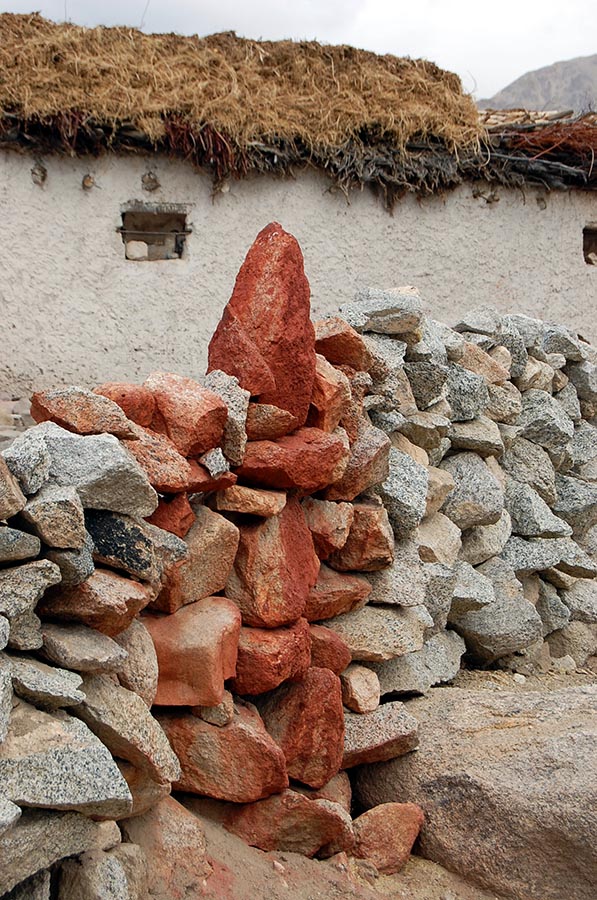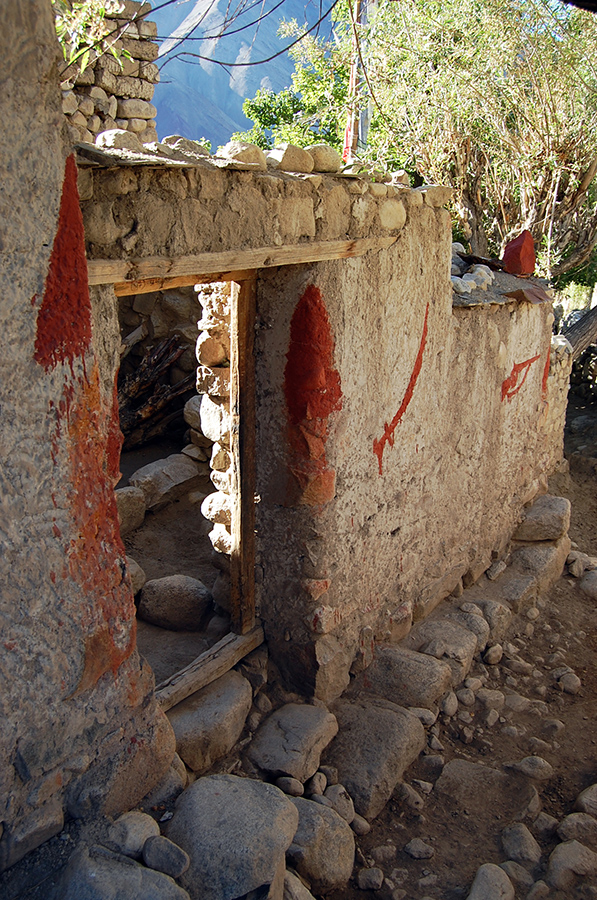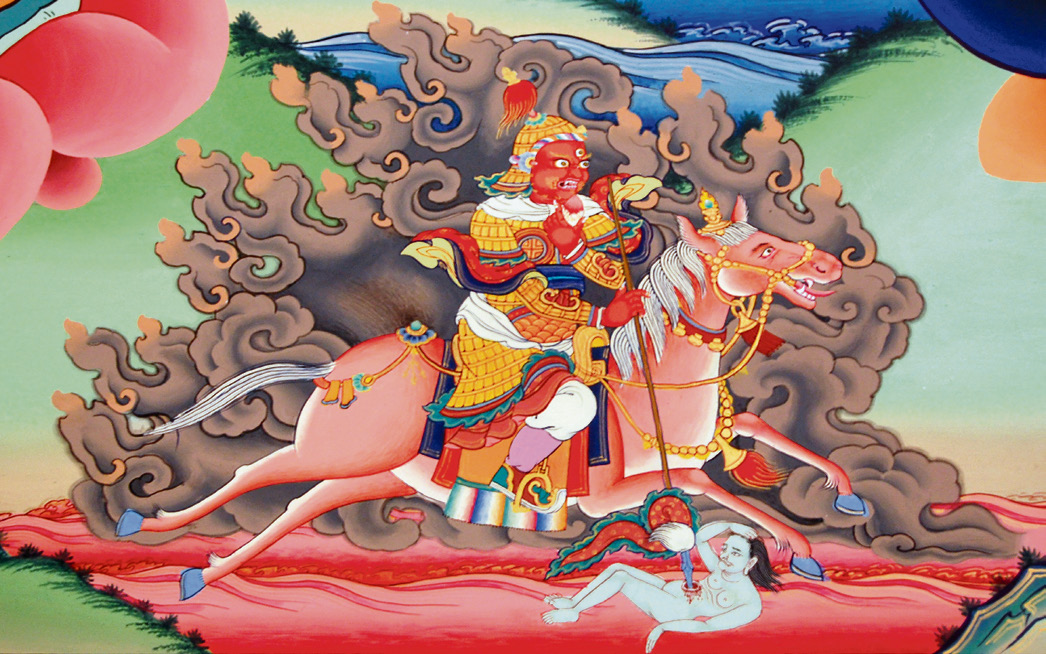Ghost Roads in Ladakh
In Buddhist areas of Ladakh, Himalayan India, red-skinned beings called tsan wander through villages at night causing illness. These spirits or “ghosts” travel along their own invisible roads that correspond to those used by humans by day, passing through villages and by houses. Almost every Buddhist house in Ladakh is distinguished by red ochre marks or stones: waymarkers for the tsan that show a Ladakhi concern with managing the movement of other beings and that attest to the potential threat to which ordinary paths and roads are open.
Waymarkers of the tsan
Buddhist houses in Ladakh almost always display red ochre marks on the walls or a red-painted stone near the front door [Fig. 1]. With a surprising degree of consistency, everyone I spoke to across the region – men and women, adults and teenagers, laity and monks, from the town of Leh to the Zangskar valley – described them as signposts or waymarkers, directing the movement of red-skinned beings called tsan or tsen (Tibetan བཙནbtsan ; pronunciation varies by region) that wander through villages at night. Tsan are a kind of lhande (Tibetan ལྷ་འདྲེ, lha 'dre, loosely “gods and/or demons”), spirits or “ghosts” in Indian English, who travel along their own invisible roads causing illness by their presence. The routes taken by these roads seem to correspond to those used by humans by day: passing through villages, by houses, connecting places of settlement and opening up lines of passage for threats from outside.

Fig. 1: Tsan stone outside a
house in Sakti, upper Ladakh.
These markers appear in different forms and under different names across Ladakh. The red-painted stones are variously referred to tsando (Tibetan བཙན་རྡོ, btsan rdo, “tsan stone”), tsandos (Tibetan བཙན་མདོས, btsan mdos, loosely, “ritual vessel for tsan”), or tsankhang (Tibetan བཙན་ཁང, btsan khang, “tsan house”), and are sometimes conflated with tsanchos zhangches, the act of setting up such a stone (Tibetan བཙན་ཆོས་བཞང་ཅེས, btsan chos bzhang ces, loosely, “to undertake a tsan ritual”). These are almost always pointed stones painted with a red ochre called tsak (Tibetan བཙག, btsag), though variations on this pattern exist: in central Zangskar people use a naturally red-tinted quartz instead, while in some areas of Sham, the lower Leh valley, they are replaced by red-painted bricks arranged in the triangular shape of an incense platform. These objects are often accompanied by tsak markings on the outer walls of houses: red triangles painted on the corners, lines of dots leading around the house, sometimes auspicious symbols like swastikas and faces [Fig. 2]. In the Sham village of Hemis Shukpachan, one house bears images of a sword and a rifle painted in tsak – emblems of the warlike tsan [Fig. 3]. 1 Most of these markings and stones are so rough and unobtrusive that an unfamiliar observer might miss them entirely.
Fig. 2: Red ochre marks and a large
tsan stone in Sankar, Leh, Ladakh.

Fig. 3: Red ochre markings including
a sword and a rifle outside a house in
Hemis Shukpachan, lower Ladakh.
Tsan
Tsan are a well-known category of spirit in Ladakh, playing a relatively prominent role in Tibetan Buddhist ritual imagery. Two of the best-known oracular deities of the region are identified as tsan: known as the red and white Rongtsan, they annually possess a pair of monks during a festival at the monastery of Matho and deliver prophecies on behalf of the former kingdom of Ladakh. 2 Several widely-known Tibetan Buddhist protector deities are closely associated with tsan – notably the dharmapāla Tsiu Marpo who, like the Rongtsan, annually possesses a monk during masked dances at the small Nyingmapa monastery of Takthok in Ladakh. These deities are typically depicted in art, ritual, and textual descriptions as appearing in the form of tsan: as red-skinned warriors mounted on red horses, clad in lamellar armour and brandishing weapons [Fig. 4]. The popular image of the spirits in Ladakh usually follows this pattern, but with one major difference: in Ladakh, and apparently in no other Tibetan-speaking areas, tsan are almost uniformly described as being “backless” creatures. From the front a tsan may appear demo (Tibetan བདེ་མོ, bde mo), “beautiful,” but from behind there is only a gaping hole where the back ought to be – organs and bones visibly jutting out.

Fig. 4: Protector deity in the form of
a tsan, Hemis gompa, upper Ladakh.
Tsan are often treated as semi-ridiculous entities. Stories I heard about personal encounters with them, or with inexplicable things later identified as tsan, often seemed to employ topsy-turvy imagery: outsized red animals met on the road at night, multiple strangers in red clothing riding a single donkey, or glowing shapes glimpsed in the distance. The Ladakhi laity I spoke to differed hugely in their attitudes towards them, as with ghosts and spirits in general. While I knew one former Buddhist monk who treated them as unquestionably real, most people I spoke to seemed doubtful of their existence at best – even asking me, on occasion, whether tsan were real. 3 The ubiquity of tsando and tsak markings does not necessarily conflict with this, but they have other purposes: the use of red markings on walls is also a way of visibly distinguishing Buddhist houses from those of Muslims, in a region where communal tensions between the two groups have become more and more fraught since the 1980s.
In keeping with their depiction as mounted warriors, tsan are commonly described as galloping through the villages of Ladakh by night. Where they linger, households suffer from illness and misfortune (Tibetan བཙན་གྱི་གནོད་པ, btsan gyi gnod pa, loosely “harm caused by tsan”): people experience bad dreams or inexplicable anxiety, ailments like fevers and paralysis, but also sudden accidents or the death of livestock. Outside of Buddhist ritual imagery and the public performance of spirit possession, it is in these experiences of misfortune that tsan are most likely to be encountered – usually after being identified as the root cause of problems by a ritual specialist, whether an onpo (Tibetan དབོན་པོ, dbon po, a diviner and exorcist) or a lay spirit medium. The process of treatment typically involves identifying where the tsan passed by the house, for tsan are understood to travel through Ladakh along their own, invisible roads: the tsanlam (Tibetan བཙན་ལམ, btsan lam, “tsan paths/roads”). Only a specialist can identify where these invisible ghost roads lie; having done so, and having located the specific tsanlam running by the house afflicted by illness, they can direct their patients to set up stones and markings to avert the tsan in future. A line of red dots painted on the walls directs the tsan to pass around the house away from the front door; a red stone, swastika, or painted sword acts as a waymarker that leads the tsan to continue along their roads. 4 , who will therefore not harm its inhabitants.” Patrick Kaplanian, “The Constituent Elements of Architecture and Urbanism in Ladakh,” Cambridge University Ladakh Expedition Reports 1977–1979 (unpublished manuscript, 1979), 136.] In effect, these stones and markings make the invisible tsanlam visible: materialising the nocturnal movement of spirits, as an attempt to control or redirect their passage through areas of settlement.
Lines of movement
What is significant about this is that it shows Ladakhis responding to threats not merely by trying to drive off or shut out harmful forces – as, say, with ritual exorcisms that cast spirits out from the area of the village, or apotropaic devices that seal up the doors of the house – but rather by trying to direct and manage their movement. Keeping the house safe involves more than ritual boundary-maintenance: it requires careful attention to be paid to the movement of spirits and other creatures around and through the village. Tsan are diverted around houses like water in a stream, as a force that can be channelled and redirected but not cut off.
In this, the process follows a pattern often seen in Tibetan medical systems, as with the use of lungta (Tibetan རླུང་རྟ, rlung rta) flags: the brightly coloured “prayer flags” used to harness and direct the flow of “wind” (Tibetan རླུང, rlung), the element or humour involved in “wind disorders.” This wind passes between the body and the outside world, and treatment of the forms of illness associated with it involves acting on the external element to bring about balance in the body. 5 As with the actions used to divert tsan, the process works not by shutting out external influences but by managing the flows of forces in the surrounding world.
Tsanlam appear to pass through every part of Ladakh inhabited by Buddhists, to the extent that their routes seem to correspond almost totally to the ordinary roads and paths used by people during the day: the roads that pass through villages and by houses, and the paths formed by repeated human movement. The idea that tsanlam could exist in areas that are not frequented by people is treated as ridiculous. When I suggested this to a group of students in a village outside the town of Leh, they laughed: why would there be tsan roads in the middle of a patch of desert, nowhere near human settlement?
In the use of tsan stones and tsak markings, we see a particular way of conceptualising the space of the village: as defined by flows of movement, of human and non-human beings, who pass between the area of habitation and the world outside. The movement of tsan mimics the processes that sustain Ladakhi villages, the constant flows of movement of people and animals and substances: of water literally flowing down from mountain glaciers; of farmers going out to work in the fields; of grazing animals kept in pens by night, taken out to pasture by day; of people travelling to the towns of Leh or Kargil for paid employment; and, increasingly, of those leaving Ladakh entirely to find work elsewhere, returning periodically (if at all) to bring back money. Villages are composed of these flows and could not exist without them, but movement brings its own dangers: of harmful forces that enter from outside, and of depopulation as people leave for good.
In his book Lines: A Brief History, the anthropologist Tim Ingold argues that “life is lived […] along paths, not in places,” and that it is through the entanglement of lines of movement that a sense of place emerges. This leads to the image of the landscape as a “meshwork” composed from the “trails along which life is lived,” the paths, stories and lines of movement of human and non-human beings that sustain and create a place. 6 This image is intended as an alternative to conceptions of places, organisms, and social units as bounded entities sealed off and separate from one another, and to static conceptions of human dwelling.
The concept of the meshwork may seem a good fit for the way Ladakhi villages are constituted by paths and movement, but this image does not quite capture the profoundly negative character of tsanlam: the appearance of these ghost roads is enabled by the cessation or contraction of human movement at night – when, as visibility reduces, people cede the space of the village to other beings – while the movement that they represent is basically antithetical to the normal operation of human life. These lines are an uncertain, unwanted, and normally invisible contribution to the meshwork of the Ladakhi landscape: associated with the passage of ridiculous and half-real beings, for most people they exist only in an implied form. They are made meaningful only in the experience of disorder, as the paths by which misfortune enters the village.
Strangers in the night
Crucially, the movement of tsan is confined to the night, when human movement is typically reduced to almost nothing. While Ladakhis tend to draw a clear distinction between the area of human habitation (Tibetan ཡུལ, yul, loosely “village” or “land”) and the uninhabited regions beyond (Tibetan རི, ri, literally “mountain” or “hill” but with broader spatial connotations), the ill-defined boundary between these two areas shifts on a daily and seasonal basis. By day, and especially in summer, the village can seem to expand to encompass its surrounding fields. At night and in winter, as people retreat indoors and spend less time moving around outside, the mountains and their inhabitants encroach on the area of habitation. In Zangskar, in autumn, bears occasionally enter villages by night and can be heard trying to break into food stores. Later in the year, across Ladakh, wolves come down from the mountains and prowl around settlements looking for stray livestock. In particularly bad winters, wolves are even occasionally spotted on the edges of Ladakh’s urbanised areas, becoming the focus for excited rumours in town. Ghosts seem to accompany these mundane threats, and they are proverbially described as entering villages by night riding on the backs of wild animals. Ghost stories are primarily associated with long winter evenings sitting by the kitchen stove – though their role as winter entertainment has been largely usurped by modern media – and encounters with ghosts are reported more frequently in the colder and darker portion of the year.
The space through which tsan and other beings move is enabled, then, by a lack of human movement: by the way people withdraw from the outside world, creating a negative space that becomes populated by non-human forces. Tsan embody the flipside of human patterns of temporality, being depicted in stories as “like people” (with men, women, and children living in tsan villages of their own) but inhabiting an inverted, nocturnal image of human social life. This is most evident in descriptions of their ghost roads, the tsanlam. While these are supposedly invisible and impossible for ordinary people to locate, the tsan stones and red ochre markings that indicate their presence are ubiquitous: there are few Buddhist houses unadorned by red waymarkers.
On some level, then, we might see tsan as presenting a kind of shadow-image of Buddhist Ladakhis. Tsan appear as strangers met at night; they travel along roads that follow the routes of human roads; and the houses of Buddhists are marked by colours and designs associated with them. The anxiety that attaches to the invisible roads of the tsan and the dangers that they pose are not clearly distinguished from the dangers of ordinary, human roads. Paths and roads attract unchecked movement that brings illness and misfortune, whether from strangers or spirits. An awareness of the village as sustained by lines of movement between the inside and outside, lines that pass across the porous and shifting boundaries that separate the village from the mountains beyond, brings with it an awareness of threat. Roads are dangerous: where people may pass by day, harmful forces move by night.
Conclusion
It would be easy to see the ubiquitous tsan stones and red ochre markings as just another species of apotropaic device, and to an extent that is simply what they are. But they are also testaments to a particular way of inhabiting a living, moving world: one in which human movement is shadowed by the movement of harmful forces that flow through areas of settlement after dark. The red stones and markings that appear outside almost every Buddhist house in Ladakh make these flows of movement visible, rendering material human attempts to manage the movement of other beings. Above all, they demonstrate an awareness of the two-sided potential of roads and paths: used by friends and by strangers, by humans and by tsan, roads are simultaneously sustaining and afflicting.
Callum Pearce is an anthropologist based in the United Kingdom. He conducted ethnographic fieldwork in Ladakh in 2013, 2014, and 2019 focused on spirits, landscape, and perception. He is currently a Post-Doctoral Research Fellow at Anglia Ruskin University, UK, working on Indigenous responses to environmental change in Inuvialuit Nunangat (the western Canadian Arctic). Email: callumjpearce@gmail.com